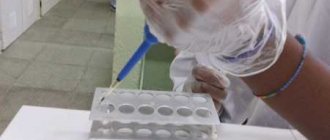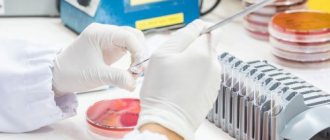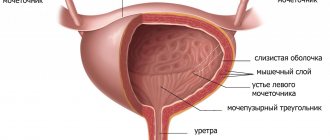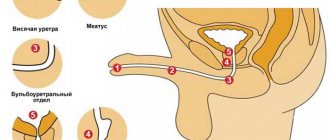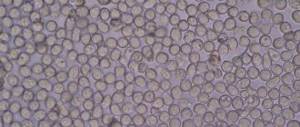If the smear test is bad
A smear from the urethra is needed for laboratory analysis to see what bacteria and infections are inside the man’s genitourinary system and whether they cause inflammatory processes that threaten health. The inflammatory process can involve the testicles, prostate gland, bladder, urethra and kidneys. The causes of an increase in white blood cells can be diseases such as:
- prostatitis;
- epididymitis;
- orchiepididymitis;
- pyelonephritis;
- cystitis;
- urethritis.
Elevated white blood cells in a smear are a symptom of sexually transmitted diseases. Even before the biological material is submitted for analysis, some symptoms clearly indicate that the inflammatory process has begun and is in full swing. Painful urination, pain in the bladder, copious curdled discharge, ulceration of the glans penis - these phenomena directly indicate that the leukocytes in the biological material taken for analysis will be increased several times.
Sometimes leukocytes are higher than normal, but inflammatory processes are not observed and tests taken do not show pathogens of sexually transmitted diseases. In such cases, the analysis is retaken a few days later.
To ensure that the study produces accurate results
In order to get an accurate analysis and find out the causes of the disease, you need to prepare for a smear test. Before the analysis, for the next three days, stop using antiseptics, antibacterial and antifungal drugs at the site of their action. It is necessary to abstain for several days from sexual intercourse and taking medications that were not prescribed by a doctor. A smear from the urethra is taken for examination two weeks after finishing taking antibiotics. Before donating biological material, two hours must pass after the last urination. Hygienic procedures related to washing the genitals are not carried out in the morning before taking a smear. If these simple rules are followed, the study will be carried out correctly and will allow you to find out whether there is an inflammatory process in the man’s body.
When taking a smear to determine the microflora of the urethra, the secretion secreted from the urethra is studied. The collected material is placed on a special glass, dried and only then examined under a microscope. In the resulting study result, the number of leukocytes can vary from 0 to 5 units for the urethra, and from 0 to 10 for the prostate in the field of view of the laboratory technician. This record appears if the taken biological material is examined under a microscope and the counting of blood cells and pathogens is carried out visually.
Modern laboratories use new technologies and count blood cells and bacteria automatically. Most often, the laboratory produces results in which the normal white blood cell count is written as follows: 2.0 x 10³. You can remain calm when reading such a post. The presence of up to 2,000 of them in a smear is considered normal. If the analysis shows any figure up to 2.0 x 10³ and there are no symptoms indicating inflammation, then there is no cause for concern.
During inflammatory processes, leukocytes in the blood increase significantly, and their number can become 20,000 per ml or more. This already indicates that it is necessary to look for the reasons for the appearance of such a number of leukocytes and conduct an examination of the kidneys, prostate gland and testicles. In some cases, the analysis identifies the pathogen that caused the inflammatory process. Most often, this analysis identifies gonococci, Trichomonas, and Candida.
Sometimes there are not very many leukocytes, but other indicators are elevated. This suggests that there is an inflammatory process, but it has become chronic, and it will be more difficult to cure. Doctors always pay attention to the content of leukocytes in tests, because this helps to identify the disease and treat it.
Share it with your friends and they will definitely share something interesting and useful with you! It's very easy and fast, just click the button for the service you use most often:
Flora smear: interpretation
A smear on the flora is a mandatory procedure for every woman. Mucus is collected from three different places in the vaginal passage during a routine examination by a gynecologist. Often such tests are taken by representatives of the fair sex who are planning a pregnancy or have undergone a treatment course. This procedure is absolutely painless.
Comparative samples are examined in laboratory conditions. The results of the analysis are recorded on a special form. You may see Latin letters whose meaning you do not know. Let's figure out together how to decipher this analysis:
- The form must indicate the places from which the comparative sample was taken, in particular: V (vaginal passage), C (cervical canal), U (urethra).
- The letter L stands for white blood cell level. Normally, the concentration of white cells is from 3 to 5 units in the vaginal canal, 5-10 in the cervical canal and from 0 to 5 in the urethra. During the study, only the visible part of the comparative sample is taken into account.
- The combination of letters Ep means the name of epithelial cells, which should normally be clean.
- The abbreviations Gn and Trich indicate the presence of gonococcus and trichomonas, which confirms the development of an infectious type of disease.
The analysis results must indicate the PH level, as well as the concentration of lactobacilli. In healthy women, tests should not contain references to the presence of fungal pathogens, Trichomonas, gonococci and other pathological microorganisms in the smear.
What do elevated white blood cells in a smear indicate in men?
- If the smear test is bad For the test to give accurate results
A urogenital smear may be taken from men to determine the condition of the urethra. If an analysis of a smear from the ureter showed elevated leukocytes and their number exceeds the norm by a thousand or more times, then this indicates an inflammatory process and the presence of an infection that caused it.
If leukocytes in the smear are elevated, it is necessary to begin an examination to find out the cause and carry out treatment.
Otherwise, the inflammatory process can spread to nearby organs and affect the entire body.
White blood cells are the cells of the immune system, which are always present in small numbers in urine tests and urethral smears. Their presence in the analysis in small quantities is considered normal, and if leukocytes are higher than normal, then this indicates pathological processes that destroy the male genital organs and require treatment. Leukocytes in a smear in men confirm the presence of an inflammatory process in the genitourinary system. The causative agent of the disease and the organ that is inflamed will be determined by the doctor after conducting additional studies.
A smear from the urethra is needed for laboratory analysis to see what bacteria and infections are inside the man’s genitourinary system and whether they cause inflammatory processes that threaten health. The inflammatory process can involve the testicles, prostate gland, bladder, urethra and kidneys. The causes of an increase in white blood cells can be diseases such as:
- prostatitis;
- epididymitis;
- orchiepididymitis;
- pyelonephritis;
- cystitis;
- urethritis.
Elevated white blood cells in a smear are a symptom of sexually transmitted diseases. Even before the biological material is submitted for analysis, some symptoms clearly indicate that the inflammatory process has begun and is in full swing. Painful urination, pain in the bladder, copious curdled discharge, ulceration of the glans penis - these phenomena directly indicate that the leukocytes in the biological material taken for analysis will be increased several times.
Sometimes leukocytes are higher than normal, but inflammatory processes are not observed and tests taken do not show pathogens of sexually transmitted diseases. In such cases, the analysis is retaken a few days later.
To ensure that the study produces accurate results
In order to get an accurate analysis and find out the causes of the disease, you need to prepare for a smear test. Before the analysis, for the next three days, stop using antiseptics, antibacterial and antifungal drugs at the site of their action. It is necessary to abstain for several days from sexual intercourse and taking medications that were not prescribed by a doctor. A smear from the urethra is taken for examination two weeks after finishing taking antibiotics. Before donating biological material, two hours must pass after the last urination. Hygienic procedures related to washing the genitals are not carried out in the morning before taking a smear. If these simple rules are followed, the study will be carried out correctly and will allow you to find out whether there is an inflammatory process in the man’s body.
When taking a smear to determine the microflora of the urethra, the secretion secreted from the urethra is studied. The collected material is placed on a special glass, dried and only then examined under a microscope. In the resulting study result, the number of leukocytes can vary from 0 to 5 units for the urethra, and from 0 to 10 for the prostate in the field of view of the laboratory technician. This record appears if the taken biological material is examined under a microscope and the counting of blood cells and pathogens is carried out visually.
Modern laboratories use new technologies and count blood cells and bacteria automatically. Most often, the laboratory produces results in which the normal white blood cell count is written as follows: 2.0 x 10³. You can remain calm when reading such a post. The presence of up to 2,000 of them in a smear is considered normal. If the analysis shows any figure up to 2.0 x 10³ and there are no symptoms indicating inflammation, then there is no cause for concern.
During inflammatory processes, leukocytes in the blood increase significantly, and their number can become 20,000 per ml or more. This already indicates that it is necessary to look for the reasons for the appearance of such a number of leukocytes and conduct an examination of the kidneys, prostate gland and testicles. In some cases, the analysis identifies the pathogen that caused the inflammatory process. Most often, this analysis identifies gonococci, Trichomonas, and Candida.
Sometimes there are not very many leukocytes, but other indicators are elevated. This suggests that there is an inflammatory process, but it has become chronic, and it will be more difficult to cure. Doctors always pay attention to the content of leukocytes in tests, because this helps to identify the disease and treat it.
Indications for the purpose of analysis
The squamous epithelium is the mucous membrane of the vagina. Depending on the phase of the menstrual cycle, cells may undergo minor changes. The surface epithelium is divided into keratinizing and non-keratinizing, the ratio of cells changes in different phases, so it is necessary to take this fact into account in order to determine whether the obtained indicators are normal.
Epithelium in a smear is normal only if its number does not exceed 15 units in the field of view. Exceeding the norm indicates the presence of inflammation or a recent infection.
The epithelium in the smear, which has a cylindrical shape, is functional, as it ensures the secretion of mucus on the cervix. Normally, the cylindrical epithelium in a smear is represented by groups of cells that have a honeycomb-like or linear structure.
In addition, goblet-shaped cells can be found, their difference is in the cytoplasm stretched with mucus. In some cases, such cells may contain secretion granules. A common pathology, ectopia, is a displacement of the columnar epithelium and its replacement of flat surface epithelium.
Leukocytes in a smear
If a diagnostic procedure called a smear for leukocytes is mentioned somewhere, then we are most likely talking about identifying sexually transmitted infections. This is a fairly common study in which the content of leukocytes, as well as bacteria, epithelium and other microscopic elements in the discharge from the genital tract is determined. Women are more familiar with this test, but the smear results also provide valuable information for “male” doctors: urologists, andrologists, so sometimes the analysis is also performed on men.
Smear in men:
The study is performed according to the following indications:
suspicion of an infectious process in the genitourinary system. If a man complains of itching, unpleasant discharge from the urethra and similar signs indicating a disease, he must be prescribed such an analysis.
A smear test is also performed on men who have no symptoms but are likely to have the disease because they have had a risk of infection (for example, contact with a partner who has been diagnosed with an STD). Finally, the test is used to track the results of treatment. If the picture of cells in the smear returns to normal, it means the person has recovered. A normal result is up to 5 cells per field of view; a conditionally normal result is 10 cells per field of view.
White blood cells are primarily a sign of inflammation; white blood cells migrate to areas where harmful microbes are trying to enter the body. Consequently, elevated leukocytes in a smear indicate some kind of infectious-inflammatory process. In men, the cause of such changes in tests is most often the above-mentioned sexually transmitted diseases, so if a person has a lot of leukocytes, then he is likely to be treated by a dermatovenerologist. Other urinary tract infections, not sexually transmitted, develop less frequently in the stronger sex.
In cases where there are much more white blood cells in the smear than normal, a urine test for leukocytes also shows their increased content.
Objectively speaking, males are very reluctant to go to doctors for a smear test. Alleged problems with men's health are a painful and sensitive topic for many of them, which they would not like to discuss even with a doctor. In addition, some patients feel that taking a sample for research is an extremely unpleasant event, accompanied by significant discomfort.
In fact, taking a sample for a smear does not involve causing pain to the person. This is slightly unpleasant, that’s all, but when performed by an experienced medical professional, the procedure generally causes minimal sensation and is carried out very quickly. The analysis of a smear for leukocytes itself is very valuable and can indicate not only the development of inflammation (if a lot of leukocytes are found in the sample), but also its immediate cause (when bacteria or other microbes are found there). Therefore, the study is very useful and is recommended to be carried out without delay by everyone to whom it is indicated.
Smear in women:
The content of leukocytes in a smear in women is approximately similar to the male analysis standards.
Either way, there are a few pieces in sight. If there are too many leukocytes, it means that the patient has an acute or low-grade inflammatory process. Not only STDs, but also other reasons can cause elevated white blood cells in a smear. Thus, women very often have diseases such as cystitis and pyelonephritis. They can be caused by various microorganisms, for example, E. coli, which entered the urethra and “climbed” up it. Women have short and wide urinary tracts, so they have an increased tendency to such diseases. The habit of dressing nicely but lightly in the cold also creates favorable conditions for hypothermia, which means it predisposes to cystitis, pyelonephritis and, ultimately, to the appearance of leukocytes in the smear.
Similar to men, a urine test for leukocytes in women can also give increased values in the presence of obvious inflammatory processes.
A smear test in women is no less useful than in male patients. However, it is worth noting that in many cases the analysis is carried out incorrectly. According to the rules, when taking a smear, it is necessary to take material not from one, but from four different areas: the urethra, vagina, cervix and rectum. In them, it is necessary to study the ratios and types of cells separately, because the norms for different zones are somewhat different.
Unfortunately, in many clinics, samples are taken only from the vagina, and therefore, the smear results are not only incorrect, but definitely incomplete. If research is done properly, it will be much more valuable.
Let's move on to the conclusions. When a man or woman has a lot of leukocytes in a smear, this means that the person is sick and needs treatment. If a similar problem happens to you, keep in mind: it is in your interests to have a full examination, and then start taking medications - as the doctor says, and for the period of time that he indicates. Finally, at the end of therapy, do not forget to take a smear for leukocytes again. Only when you get normal results can you relax.
To make the treatment of infectious and inflammatory processes more effective, it is recommended to take additional means to support the immune system. A drug called Transfer Factor is one of the most effective means for improving the functioning of the immune system. The maximum level of safety, proven effect on phagocytes and lymphocytes, and the absence of toxic effects on the body help make treatment more successful.
How is the analysis done?
The analysis is most often taken by a doctor when you come to him for a regular appointment at the clinic or when you simply go to a paid laboratory, where obstetricians and medical staff take biomaterial from you.
The procedure for taking a smear is completely painless.
For women, a gynecologist, obstetrician or any other medical professional lightly runs a special disposable stick-shaped spatula over three points - the vagina, urethra and cervical canal.
In men, a urologist or another doctor inserts a special disposable probe into the urethra, turns it around its axis several times and takes an analysis. It is believed that the examination does not cause pain, however, this does not exclude the carelessness of the doctor, as well as individual sensitivity or the presence of a particular disease, which can cause discomfort.
An increase in leukocytes in a smear in men and women
The reproductive function of the body is influenced by many factors. One of the most common and most common is infection of the genital organs in both women and men. To determine infections, a bacteriological examination of a smear on the flora of the genital organs is used. If the content of leukocytes in the smear is increased, this indicates the presence of infection. The results of the study, as well as the patient’s complaints, allow the doctor to determine the cause causing the increase in leukocyte levels and prescribe treatment.
Causes of increased leukocytes in women
Doctors' opinions regarding the leukocyte norm are controversial. Some argue that the leukocyte content should not exceed 3 units in the visible area. Others believe that the normal level of white cells is up to 15 units. But it is worth noting that most specialists adhere to the limits from 0 to 3, and therefore this level can be taken as the norm. To ensure the reliability of the study of flora when analyzing a smear using a laboratory method, a classification of the degree of vaginal cleanliness is used:
- 1st degree – clean vagina, leukocyte count from 0 to 3;
- 2nd degree – leukocyte content up to 15 units, with beneficial bacteria and microorganisms present;
- 3rd degree – up to 50 units, this concentration is observed before menstruation or immediately after it;
- Grade 4 – above 50 units, such a high content means the development of an inflammatory process and is often recorded in the analysis form as “solid or solid”.
Along with a flora smear, a cytology test is performed to determine whether there is inflammation of the cervix. The study of flora in women makes it possible to determine the presence of pathogens such as mushrooms, gonococci, trichomanas and others. If elevated leukocytes are observed in the smear, the cause may be the following diseases:
- colpitis;
- urethritis;
- adnexitis;
- cervicitis;
- oncology;
- disturbance of the intestinal and vaginal microflora.
If the increased concentration of leukocytes in a woman is persistent, this means that additional examination is necessary. It is required to take a culture test for flora and sensitivity to antibiotics, which allows you to determine the presence of pathogens and their sensitivity to antibacterial drugs. Treatment should begin with restoring the microflora in the vagina. For this, medicinal herbs are used, douching with a chlorophyllipt solution is effective. Treatment often requires the use of special suppositories, for example, pimafucin.
Causes of increased leukocytes in men
In men, the following values are taken as the norm of leukocytes when examining a smear: when taking material from the urethra, from 0 to 5 units, and from the prostate, from 0 to 10 units. An increased amount determined during the study means that the process of inflammation is progressing and there is an infection causing it. Before you begin to treat elevated white blood cells in a smear, you need to undergo additional examination to determine why their level is increasing.
The inflammatory process in men can affect the entire genitourinary system, and in a prolonged form, nearby organs. Among the causes of an increased number of leukocytes, the following pathologies can be identified:
- prostatitis;
- epididymitis;
- orchiepididymitis;
- pyelonephritis;
- cystitis;
- urethritis.
Sexually transmitted infections also cause an increase in the number of white blood cells. A large number of external symptoms and complaints may indicate infection of the reproductive system, for example, cutting pain in the bladder area, heavy discharge, pain when urinating, ulceration of the head. These complaints almost always indicate that the result of the smear test will be poor.
There are cases when an increase in the level of leukocytes is detected, but inflammation is not observed and the presence of infections is not determined during the study.
In this case, you need to wait a few days and then take the test again. Treatment aimed at lowering white blood cell levels in men should be determined by a doctor based on the cause of inflammation. Most often, therapy is aimed primarily at eliminating the pathogen using antibiotics.
Increased rate during pregnancy
During pregnancy, a smear is the first test that a woman undergoes when registering. A slight increase in the concentration of leukocytes between 15 and 20 units is accepted as normal. If a smear during pregnancy contains only leukocytes, then this is a sign of inflammation and infection, which poses a certain danger to the child. To establish the reason for the increase in concentration, you need to undergo additional examination.
Perhaps the infection was in the body before, and during pregnancy, when hormonal levels began to change, the immune system began to become more active. During the period of bearing a child, it is important to monitor the state of health, as the protective function decreases and infections can begin to progress. Many sexually transmitted infections begin to manifest themselves only during pregnancy and can harm the development of the child. An increase in white blood cells is often observed with thrush, which worries women in late pregnancy.
How to lower leukocytes in a smear when carrying a child should be determined by a doctor. Treatment during pregnancy is difficult due to the fact that many antibiotics are contraindicated during this period. It is necessary to take a responsible approach to the choice of therapy, otherwise in complicated cases the uterine cavity may become infected and threaten the child’s health. Most often, doctors prescribe vaginal suppositories and herbal decoctions. Under no circumstances should you self-medicate, as this is dangerous for the unborn child.
Leukocytes bring great benefits to the body, as they provide its protective function. A high level of leukocytes in both men and women indicates an ongoing inflammatory process and infection, and accordingly requires treatment. Therapy aimed at reducing concentration should only be prescribed by a doctor after a thorough examination. For example, during pregnancy, treatment with antibiotics is contraindicated and a specialist may prescribe suppositories, herbal decoctions, or douching.
Symptoms of leukocytosis
A condition characterized by an excess of white blood cells (leukocytes) in the blood is called leukocytosis. Cells protect a person from the invasion of viruses and prevent their reproduction. A constant elevated level of leukocytes is the result of an inflammatory process of various etiologies, which is often accompanied by the following symptoms:
- burning sensation and unpleasant odor from the vagina;
- pain when urinating;
- white curdled vaginal discharge;
- painful sexual intercourse;
- disruption of the menstrual cycle;
- itching of the genitals;
- unsuccessful attempts to get pregnant;
- temperature increase;
- dizziness.
- Bechamel sauce for lasagna
- Which countries have the most dangerous strains of coronavirus?
- What is a health book, how to get a document
Leukocytes in a smear
If you look at the composition of the content cells in an abscess on the skin, then 90% of the cells will be leukocytes - the main cells of pus.
Leukocytes in a smear are an immune response to many causes.
Norms of leukocytes in smears
Normally, in a smear from the urethra in men and women, there are up to 2 leukocytes in the field of view of the microscope.
In a smear from the vagina and cervix, up to 10 in the field of view.
The white blood cell count in a vaginal smear may be slightly elevated during pregnancy.
In this case, their concentration is usually 15-20 in the field of view.
How to prepare if you need to take a smear for leukocytes
In order for the results of the smear to be as reliable as possible, it is necessary to properly prepare for the procedure.
The rules are simple and easy to follow.
Before performing the analysis you must:
- 1. Avoid sexual intercourse a couple of days before the smear;
- 2. Do not use drugs for local treatment two days before the appointed day. If you are undergoing treatment, consult your doctor;
- 3. You should stop douching for several days before taking the test;
- 4.Refrain from urinating at least two hours before taking a smear;
- 5. Carry out a thorough toileting of the genitals in the evening, before the day of collection of materials. You should wash yourself with warm water, but without using soap or other hygiene products;
- 6. Antibiotic intake should be limited 1-2 days before taking a smear;
- 7.Girls need to take a smear 3-5 days after the end of menstruation and no later than a few days before it begins.
Remember! Performing a smear during menstruation can greatly distort the data obtained.
How is a smear taken for leukocytes in women?
The sampling is carried out with a special sterile instrument, which differs depending on the location of the smear.
The main instruments are a Volkmann spoon, a bacteriological loop, a gauze swab or an Eyre spatula.
The choice of instrument depends on the location of the smear.
After collection, the resulting material is applied to glass slides marked C, V or U.
These letters indicate the location from which the smear was performed.
This procedure is completely painless and is carried out in a short period of time.
When collecting material from the urethral canal, you may feel discomfort.
Taking a smear for leukocytes in men
In a man, a special probe or cotton swab is used to obtain the material.
It is inserted into the depth of the urethral canal 3-5 centimeters.
Next, the resulting material is applied to a glass slide and sent to the laboratory.
As with women, the procedure is painless, but some discomfort may occur.
All indicators of elevated white blood cells in a smear are called leukocytosis in a smear.
Causes of elevated white blood cells in smears in women and men:
- Sexually transmitted infections (STDs)
- Bacterial inflammation of the genital organs (dysbacteriosis)
- Urolithiasis disease
- Inflammation of the female genital organs (colpitis, vaginitis, endometritis)
- Inflammation of the male genital organs (prostatitis, inflammation of the testicles)
- Inflammation of the bladder (cystitis)
- Kidney inflammation (pyelonephritis)
Increased leukocytes in a smear during sexually transmitted infections
Almost all sexually transmitted infections (STDs) cause inflammation in response and, as a result, an increase in leukocytes in the smear.
Most often, leukocytes increase when:
- I. Gonorrhea
- II. Trichomoniasis
- III.Mycoplasmosis
- IV. Ureaplasmosis
- V. Candidiasis
- VI. Gardnerellosis (bacterial vaginosis)
However, with an increase in leukocytes in the smear, all sexually transmitted infections, including viruses, are excluded.
An increase in leukocytes in a smear during bacterial inflammation of the genital organs
- Bacteria that normally live in the genitals are exceeded in number
- Bacteria inhabit the genitals that should not live in these areas
To exclude this process, a culture is performed to determine sensitivity to antibiotics.
Subsequently, the required antibiotic is prescribed in combination with enzymes and local treatment.
Smear technique
A smear for cytology is taken using a special spatula, which is available in a standard gynecological kit intended for examination. It is necessary to take the analysis at the site of transformation (where the squamous epithelium turns into columnar epithelium); after taking the material, it is distributed over a glass slide.
The transformation zone is located in the area of the external pharynx, but in some cases (depending on hormonal balance and age) it can change its position. Taking a smear from the area of transitional epithelium is necessary to accurately determine the presence of malignant cells.
That is why the epithelium in the smear plays a very important role. The norm in women ranges from 3-15 units in the field of view. If their number is higher, additional examinations need to be carried out to detect a malignant tumor.
Collecting material and conducting research
A slight increase in the number of white cells is not always a symptom of a developing disease. There are cases when a doctor issues a referral for a repeat test, the result of which later turns out to be normal. Incorrectly collected biomaterial can distort the answer.
In order to accurately determine the number of leukocytes in a smear, men need to prepare for the test in advance.
- 3 days before the delivery of biological material, do not use:
- antiseptics;
- antifungal drugs.
- A minimum of a week, or better yet 14 days, should pass after taking antibiotics.
- Avoid sexual intercourse and heavy physical activity for several days.
- Avoid visiting bathhouses and saunas.
- Wait at least 2 hours after your last urination.
- Do not wash the genital organ before the test, the day before or in the evening, do not use soap or cosmetics.
- Do not drink alcohol for at least two days and refrain from smoking several hours before the test.
Preparing for tests
Biomaterial - secretion secreted from the urethra, is collected with a special instrument. A cotton swab or probe is inserted into the urethra to a depth of 5 cm, the biological material is placed on sterile glass, dried naturally and examined using a microscope.
This procedure does not cause pain, but many men, for various reasons, try to avoid it.
Leukocyturia is diagnosed by a general urine test. There are a number of methods for studying urine.
| • take the test again; | |
| 15-40 | • acute inflammation of the bladder or ureter; |
| • collect a smear from the urethra; | |
| 40-100 | • inflammatory disease of the prostate gland; |
| • Ultrasound and prostate biopsy; | |
| above 100 | • inflammatory disease of the prostate gland; |
| • take a biochemical blood test; | |
| Method | Explanation |
| Nechiporenko's technique | In the morning, the patient collects a medium portion of urine. This technique is considered the simplest and most common, since it does not take into account daily fluctuations in leukocytes. |
| Two-glass sample method | One urination is divided into two portions, excluding the middle urine. An increase in the number of leukocytes in the first portion indicates inflammation of the urethra or prostate gland, in the second - pathologies of the bladder, kidneys, and ureter. |
| Three-glass sample method | Similar to the two-glass sample method, urine from one void is continuously divided into three containers. If the number of white cells is higher in the first glass, it indicates inflammation of the urethra; approximately the same number in all containers indicates kidney disease; bladder disease is present if there are more leukocytes in the second and third containers than in the first. |
| Amburger method | Urine collected in one minute is subject to examination. |
| Rofe method | The number of white elements in urine collected in one hour is calculated. |
| Kakovsky-Addis method | The number of leukocytes in urine collected per day is determined. |
| Method for qualitative assessment of leukocyturia | Different types of leukocytes are recognized by staining the urine sediment with a special composition. In this way, Sternheimer-Malbin cells, which are present in patients with acute and chronic pyelonephritis, are determined. |
It's no secret that monitoring your own health prevents the development of serious diseases. This article described in detail the reasons for the increase in white blood cells. It goes without saying that if the number of white cells has increased, a dangerous disease is already present in the body, but immediate treatment reduces the likelihood of complications and saves life.
Leukocytes in a smear in men make it possible to diagnose inflammatory processes and sexually transmitted diseases at an early stage. The article explains the mechanism of operation of the body's immune system and describes the procedures of modern medicine that allow timely detection of a disease associated with an increased number of leukocytes in a smear and urine.
Collection of material for research
Before getting acquainted with the various ways to study urine, let us briefly consider the physiological process of its formation.
The human body contains a pair of organs, the kidneys, whose main job is to filter the blood. As a result of this process, urine or urine is formed, which is then collected in the so-called renal pelvis and discharged into the bladder for further removal from the body. All this work is carried out by nephrons, the complex structure of which can be very schematically divided into several parts:
- capillary glomerulus;
- Bowman's capsule surrounding the glomerulus;
- proximal and distal tubules;
- collecting ducts.
Urine formation occurs in three stages:
- filtration of blood plasma, as a result of which primary urine appears;
- the process of reabsorption, that is, the reabsorption of purified plasma into the blood;
- secretion or formation of secondary urine intended for excretion from the body.
Correctly collecting urine for analysis is very important: this will help avoid mistakes in diagnosis. On the eve of the test, you should not eat foods that can affect the color of your urine: beets, carrots, berries. The test is taken on an empty stomach in the morning after a thorough hygiene procedure.
You should purchase sterile containers with a tight lid for one-time use at the pharmacy. The vessel is filled halfway as follows: the beginning of urination occurs in the toilet, the middle part - in the container for collecting urine, the final part - again in the toilet.
These are the rules for collecting urine for most types of analysis, but sometimes special preparation is required. For example, two days before donating urine for oxalates, you must stop taking medications containing vitamin C. If necessary, your attending physician will inform you about all the nuances of preparing for the test.
Conducting research
Many types of urine tests help your doctor make a diagnosis.
General analysis
The average citizen, not experienced in the intricacies of medicine, is well acquainted with a general urine test, since it is most often prescribed. After all, urine is waste substances that can be used to determine the general condition of the body.
In particular, with its help, pathologies of any organ of the urinary system, kidney diseases and urolithiasis are diagnosed at an early stage.
During the examination of general analysis material, laboratory assistants pay attention not only to the composition of urine, but also to its external characteristics: color, transparency, the presence of foreign inclusions, odor, density.
Daily diuresis
Conducting a urine test
As the name suggests, urine is collected over a period of 24 hours. Of course, this is only possible in a hospital setting. This analysis is necessary to determine the level of creatinine, which indicates the presence of diabetes mellitus, genitourinary tract infections, and kidney diseases. If deviations in urea and protein readings are observed in the sample, this is a signal of problems with the thyroid gland or anemia.
Urinalysis according to Nechiporenko
It is prescribed, as a rule, after a general analysis, if it has raised the doctor’s suspicion of the presence of a hidden infection. In samples using this method, the number of formed bodies that appear in various pathologies is examined. In addition to leukocytes, erythrocytes are very informative, the excess of which is an indicator of nephrotic syndrome and glomerulonephritis.
In what cases is this analysis prescribed?
To prevent diseases, this smear should be taken systematically. But often a man turns to a specialist for help when discomfort in the genitals occurs. The doctor prescribes taking a smear if there is a suspicion that the patient has developed any disease of the genitourinary system or if obvious deviations from the norm are observed. Also, indications for prescribing an analysis include taking antibiotics for a long time and conducting a preventive examination.
Treatment of non-infectious vaginitis
The predominant amount of epithelium in a woman’s smear may indicate the presence of an inflammatory disease of various types. A sign of vaginitis, in addition to a large number of epithelium in the smear, are symptoms such as unbearable itching of the vaginal area, unpleasant odor and redness of the genitals.
Vaginitis can be caused by infection or irritation in response to a chemical, such as intimate hygiene gel or soap. In rare cases, vaginitis causes a sharp drop in hormone levels, for example, during menopause.
A high level of epithelium is present in the smear and with inflammation of the urethra. The causative agent of this disease can be almost any virus, including herpes. In some cases, the disease is caused by an individual reaction to products that come into contact with the intimate area.
READ MORE: Pimafucin for thrush - how to take for women and men
Infectious urethritis is treated with antibiotics. If painful symptoms are present, analgesics are prescribed. During treatment, it is recommended to temporarily stop sexual activity, monitor genital hygiene and refuse any medical products intended for vaginal use.
A change in the shape and amount of epithelium in a smear may indicate dysplasia or the development of a tumor. The first disease is not cancer. As a rule, it goes away after a certain amount of time.
In the second case, everything is much more complicated, but there is a possibility that the tumor will be benign. Therefore, there is no need to panic. The doctor will prescribe the necessary treatment, which may include cryotherapy, diathermy, or laser removal of tumors.
If the epithelium in the flora smear is increased, and no infections were detected, we can conclude that a non-infectious pathogen is present. These may be hygiene products containing chemicals that cause irritation of the mucous membrane, contraceptives, or with increased sensitivity of the vagina to spermicides.
In these cases, it is enough to stop using the products, and after some time the concentration of epithelium in the smear will itself restore to normal levels. To speed up the effect, you can use suppositories or tablets that normalize the vaginal microflora and allow normal cells to recover faster.
Research price
The results of a smear for flora are usually ready the next day, since the study is not specific and complex, so you can pick up your tests quickly enough. A smear on the flora is indeed considered a fairly simple test that can be done in a regular clinic for free.
The price of the study varies from 440 to 550 rubles, and in addition, you can pay separately for the collection of biomaterial by a medical professional. The total will be approximately 900-1000 rubles.
Symptoms
Symptoms that are indicative of a mandatory smear:
- Feelings of pain, heaviness and discomfort observed in men in the genital area.
- Complaints of burning and itching in the urethra.
- The appearance of a rash on the penis.
- Frequent, painful urination and other related problems.
- Observation of pathological discharge from the urethra.
- The appearance of swelling in the genital area and groin, the appearance of discharge from the penis or blood in the urine and semen.
If you have unpleasant symptoms, you should immediately visit a doctor, take a smear and get tested for the presence of sexually transmitted infections. What epithelium means in a smear depends on the characteristics of its cells and their structure and quantity.
Why is columnar epithelium detected in a smear in men? We will tell you about this further.
What is determined by a urethral smear? Various sexually transmitted diseases, the presence of pathogens, progression of the inflammatory process.
Why do squamous epithelial cells appear in urine?
If there is a large amount of atypical epithelium, radical methods aimed at destroying cells may be required. After this, the number of cells is normalized, and the epithelium in the smear is restored.
The norm for women during the recovery period is individual, so after surgery, after some time you need to visit a gynecologist and take a smear test again.
The following methods are usually used to treat dysplasia:
- Laser therapy is the most modern and effective method. In addition to removing the atypical area, you can also examine its depth and act on all layers of tissue. This procedure is very painful and traumatic, so bleeding may begin after a few days.
- Diathermy - cauterization, is the effect of electricity on an atypical area. It is the fastest and easiest method. After cauterization, scars may remain on the cervix, which in some cases cause the development of infertility.
- Cryothermy is the effect of ultra-low temperatures on the damaged area. The method is effective only in the initial stages of dysplasia. With the development of cancer cells or the occurrence of atypical processes in the cells of the basal layer, it does not produce any results.
All these procedures are aimed at destroying atypical cells under the influence of temperature or a laser beam. In place of the destroyed cells, squamous and cylindrical epithelial cells appear, which are normal for the cervix and vagina.
The epithelium in the smear, the normality of which has been restored after such procedures, will not carry the risk of developing cancer. If the treatment procedures are not effective, it is likely that a hyperectomy (removal of the uterus and cervix) will have to be performed.
